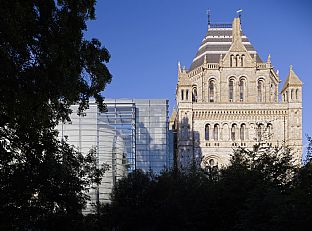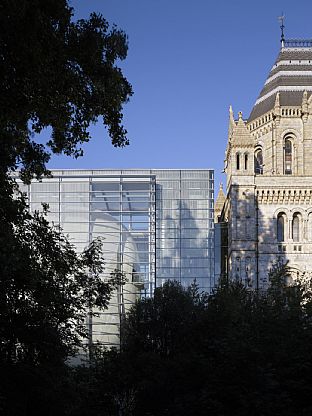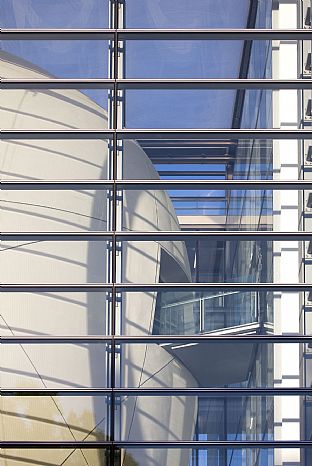2.9.2008
Danish cocoon completed for London's insects
An eight-storey cocoon-shaped extension has now been completed for the Natural History Museum in London. C. F. Møller Architects was responsible for the design of this expressive building, which will open to the public in September 2009.
The new Darwin Centre will house the museum's unique collection of 17 million insects and three million plants, as well as working laboratories for 220 scientists from all over the world. When the extension opens to the public in 2009, museum guests will be able to explore the inside of the cocoon-shaped building and watch the scientists work with the collections.
Anna Maria Indrio, a partner at C. F. Møller Architects, comments: "The second phase of the Darwin Centre takes the form of a large silk cocoon protected by a glass atrium which encloses a fantastic treasure, reflecting evolution itself. The macroscale of the space and the size of the cocoon expresses the enormous importance of the collections. Iconic forms should only be used if the relationship between the building and its interpretation is entirely self-evident, as it is in this case. The new building will completely change the Natural History Museum's relationship to the site from being an introvert to an extrovert building."
C. F. Møller Architects won the commission to design the second phase of the Darwin Centre in an international competition in 2001. The building is the most significant development at the Museum since it moved to South Kensington in 1881. The first phase, housing the Museum's 22 million zoological specimens stored in alcohol, opened in September 2002.
"C. F. Møller Architects is very proud and honoured to have been given the task of designing a framework for the Natural History Museum's unique collection of plants and insects. It has been a very great challenge, and we are looking forward to seeing the building take shape. It has been incredibly demanding to solve the task of the second phase of the Darwin Centre in this way, so I really hope the cocoon will become a major attraction and a trademark of the Darwin Centre and of the city in the future," says Anna Maria Indrio.
Dr Michael Dixon, Director of the Natural History Museum, comments: "As well as being a world-famous visitor attraction, the Natural History Museum has hundreds of our own scientists and thousands of others who are visiting, all working with our 70 million specimens - from meteorites and dinosaur fossils to Darwin's finches and the Thames Whale. Up until now, most of our science has been going on behind the scenes. At the Darwin Centre, we will show the public more of both our vital research and our internationally important collections. There is no other museum in the world that brings the public and scientists together in this way or on this scale."
C. F. Møller Architects is now working on yet another fine new museum project in London, namely a new knowledge centre for the National Maritime Museum in Greenwich. The National Maritime Museum houses the world's most important maritime collection in distinguished historical buildings which are included on UNESCO's World Heritage List of cultural sites worthy of preservation.
The new Darwin Centre in figures
- C. F. Møller Architects was selected for the commission from among 59 architectural practices in an international competition held in 2001
- The second phase of the Darwin Centre will cost £78 million
- The new Darwin Centre will have 16,000 square metres of floor space
- At 60 metres long, 12 metres wide, 300 millimetres in depth, and covering 3,500 square metres, the eight-storey high cocoon is the largest curving sprayed concrete structure in Europe
- The cocoon will hold 17 million entomological specimens and three million botanical specimens in 3.3 kilometres of cabinets
- The cocoon has walls which are approximately 30 centimetres thick, and will be kept at a steady 17°C and 45 per cent relative humidity - the optimum conditions in which to store collections
- The building will accommodate 220 staff members and visiting scientists
- 2,500 people per day will be able to take a self-guided journey through the collections and research areas
- The Darwin Centre will open to the public in September 2009
LINK TO FILM ABOUT DARWIN CENTRE
DOWNLOAD PDF: ARCHITECTURAL DESCRIPTION
DOWNLOAD PDF: Anna Maria Indrios CV







